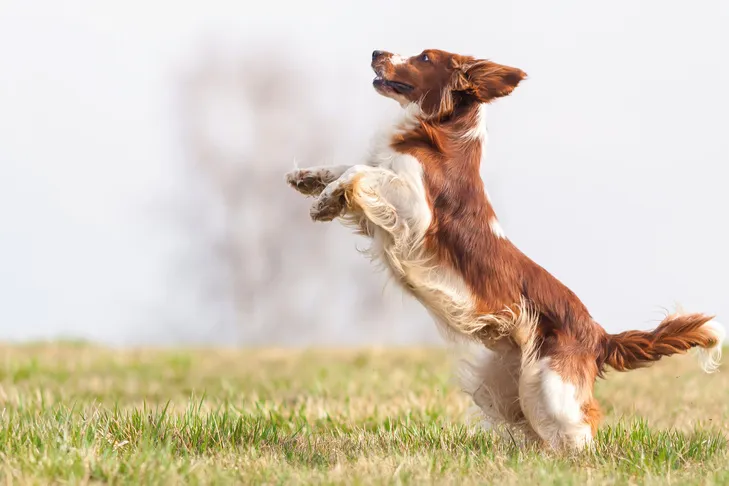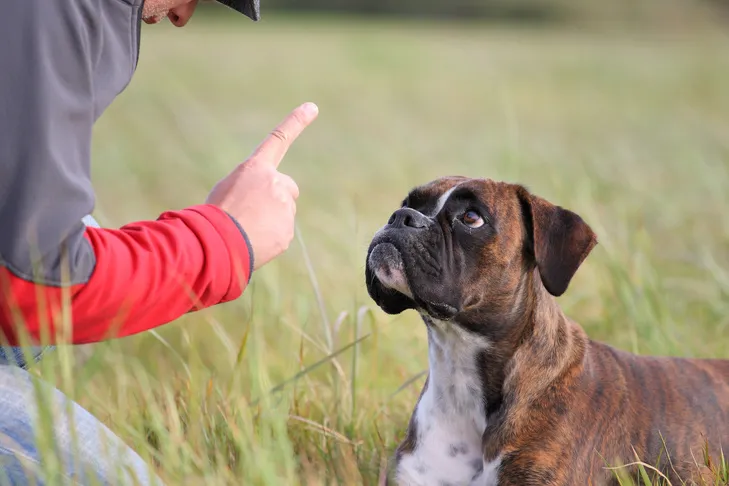Jumping up is a common dog behavior, often intended as an enthusiastic greeting. While your furry friend is simply trying to say “hello” face-to-face, this behavior can be problematic. Large breeds can accidentally knock people over, posing a risk, especially for children and seniors. Even smaller dogs can cause discomfort, scratch legs, or leave muddy paw prints on clothes. Moreover, jumping is an effective way for dogs to gain your attention, reinforcing the habit. This guide will provide ten effective tips on How To Prevent Your Dog From Jumping, helping them learn appropriate greeting etiquette and fostering a more polite interaction with humans.
The key to managing this natural canine impulse is to teach your dog a clear greeting rule, such as “keep all four paws on the floor.” This alternative behavior is not only safer and more polite but also gives your pet a constructive way to welcome you home and earn your desired attention. By consistently applying these methods, you can guide your dog to understand exactly how to greet people appropriately. Consistency and positive reinforcement are paramount for successful training. Many owners seek guidance on specific training techniques, and understanding how do you get your dog to stop jumping up is a crucial step towards a well-behaved companion.
1. Only Greet Your Dog When All Four Paws are on the Floor
The most effective approach to addressing problematic behaviors is to teach an alternative, incompatible action. Dogs learn more quickly and easily when you instruct them on what to do, rather than just what not to do. For jumping, this means training your dog to keep all four paws firmly on the ground. A dog cannot jump and stand simultaneously. Alternatively, you might prefer them to sit or lie down during greetings. Whichever rule you establish, it is essential to only provide attention and greet your dog when they are adhering to this rule. Consistency is vital; for instance, avoid allowing your dog to jump on you when you’re wearing casual clothes but not when dressed formally.
2. Provide Immediate Attention When Your Dog’s Front Feet are Down
Dogs naturally repeat behaviors that lead to desired outcomes. Therefore, as long as your dog follows your greeting rule, such as keeping their front feet on the floor, reward them with praise and petting. Your dog craves your attention as a reward, so ensure they receive it immediately whenever they perform the correct action, especially during the learning phase. Do not delay your greeting to perform other tasks like removing your coat or shoes. Your dog might grow impatient and resort to jumping or other attention-seeking behaviors. Prompt reinforcement helps your dog connect the desired action with the reward.
3. Withdraw Attention When Your Dog Jumps
Conversely, to stop jumping, you must cease rewarding it. Never reinforce a behavior you wish to eliminate. If your dog jumps on you, promptly remove the attention they seek. This could involve calmly turning your back or walking away, signaling that jumping yields the opposite of their intended effect. However, the moment your dog returns to “four on the floor,” turn back and offer quiet praise and gentle petting. This consistent response helps your dog understand that their behavior acts as a switch, turning your attention on and off based on their actions.
 Welsh Springer Spaniel jumping up outdoors.
Welsh Springer Spaniel jumping up outdoors.
4. Set Your Dog Up for Success During Greetings
While ignoring jumping and rewarding proper greetings is effective, it can sometimes be frustrating for your dog, as it relies on trial-and-error learning. You can expedite the process by setting your dog up for success, making it easier for them to follow your greeting rule. If your rule is for them to sit for greetings, ask them to sit as soon as you enter. If “four on the floor” is your preference, encourage them to stay standing. A fantastic technique to prevent jumping is to scatter treats on the floor upon entry. Most dogs can’t resist a free treat, and they cannot jump while sniffing the ground. Be quick; if you provide food before your dog even considers jumping, you can reward “four on the floor” with both attention and treats. Your dog will quickly grasp the greeting rule, and you can gradually phase out the food rewards.
5. Always Reward Proper Greeting Behavior Consistently
Your dog will master appropriate greeting behavior more rapidly if their actions immediately influence your attention—keeping front feet on the floor earns attention, while jumping makes it disappear. This means you must consistently reward your dog when they adhere to your greeting rule. Never withhold attention once your dog’s feet touch the floor, regardless of any prior frustration you might feel from sustained jumping. Inconsistent reinforcement can confuse your dog and impede their learning progress. Strive for unwavering consistency to ensure they understand the rule. As your dog learns to manage their excitement around greetings, they might also benefit from broader obedience training, such as getting a dog to walk to heel to enhance their overall self-control.
6. Avoid Grabbing or Pushing Your Dog Away
It’s crucial to remember that your dog jumps to gain your attention. Even a negative physical response, such as grabbing your dog, holding their paws, or pushing them away, still constitutes attention. Consequently, this can inadvertently reinforce the jumping behavior rather than reduce its frequency, potentially leading to more jumping in the long run. Worse still, for many dogs, physical interaction can be misinterpreted as an invitation to engage in roughhouse play, causing them to return with more vigor, believing it’s part of an enjoyable game.
 American Hairless Terrier jumping up on the leg of its owner outdoors.
American Hairless Terrier jumping up on the leg of its owner outdoors.
7. Do Not Use Your Knee to Block Your Dog
You might have heard the advice to raise your knee to block your dog’s chest when they jump as a deterrent. However, as previously discussed, this physical interaction can be perceived as attention or an invitation to a wrestling match by some dogs, particularly those with a playful disposition, leading to the opposite of the desired effect. More importantly, for most dogs, this action can erode trust and damage the crucial human-canine bond. Your dog is merely attempting to greet you, and responding with perceived punishment can be detrimental. Furthermore, there’s a risk of injury to your dog. A dog that loses trust in its owner may develop other behavioral issues, such as a reluctance to come when called.
8. Maintain Low-Key Greetings During the Learning Phase
Dogs often struggle to control their excitement when greeting their beloved humans. It demands significant emotional self-control to resist the natural urge to jump and instead obey a new greeting rule. To make this easier for your dog, keep greetings subdued and calm. Dogs are highly perceptive of our emotions; if you are overly excited, they will mirror that energy. Instead, maintain a quiet and calm demeanor, even when offering praise. As your dog begins to grasp the new behavior, you can gradually increase your enthusiasm until you can match their joy without triggering jumping. Developing this self-control is also vital for advanced training, such as when you how to train your dog to be a therapy animal.
9. Implement Management Techniques to Prevent Jumping on Guests
Your dog’s behavior isn’t solely reinforced by you. Family members, guests, and even strangers encountered outside can inadvertently reward jumping if you’re not diligent. To proactively prevent this, utilize management techniques. Leashing your dog when visitors arrive can restrict their ability to approach and jump. An even more effective strategy is to “send your dog to their place,” such as a designated mat or bed, or place them in their crate, ensuring they are away from the immediate greeting area near the door. Using a baby gate to block access to the front hall can also be a simple yet effective barrier.
 Boxer laying down outdoors being trained by a man.
Boxer laying down outdoors being trained by a man.
10. Educate Guests and Strangers on Your Greeting Rules
Don’t hesitate to communicate your dog’s greeting rules clearly to guests and strangers. While your dog is still learning, politely ask people to completely ignore your dog unless you explicitly give permission. It’s often beneficial to avoid encounters with strangers until your dog has mastered appropriate greetings with friends and family members who you know will cooperate with your training efforts. When encountering strangers, you can also use a “watch me” cue to redirect your dog’s attention, or distract them with a hand touch target or a favorite toy until the person has passed. These strategies are particularly helpful when working towards more complex goals like how to train your dog into a therapy dog.
Preventing your dog from jumping is a common challenge for many owners, but with patience, consistency, and the right approach, it’s a highly achievable goal. By focusing on teaching an alternative, polite greeting behavior, reinforcing it positively, and managing environments where jumping might occur, you can help your dog become a more courteous companion. Remember, every interaction is a training opportunity. Stay calm, be consistent, and celebrate small victories. If you encounter persistent difficulties, consider consulting with a certified professional dog trainer for personalized guidance to reinforce appropriate greeting behaviors.
